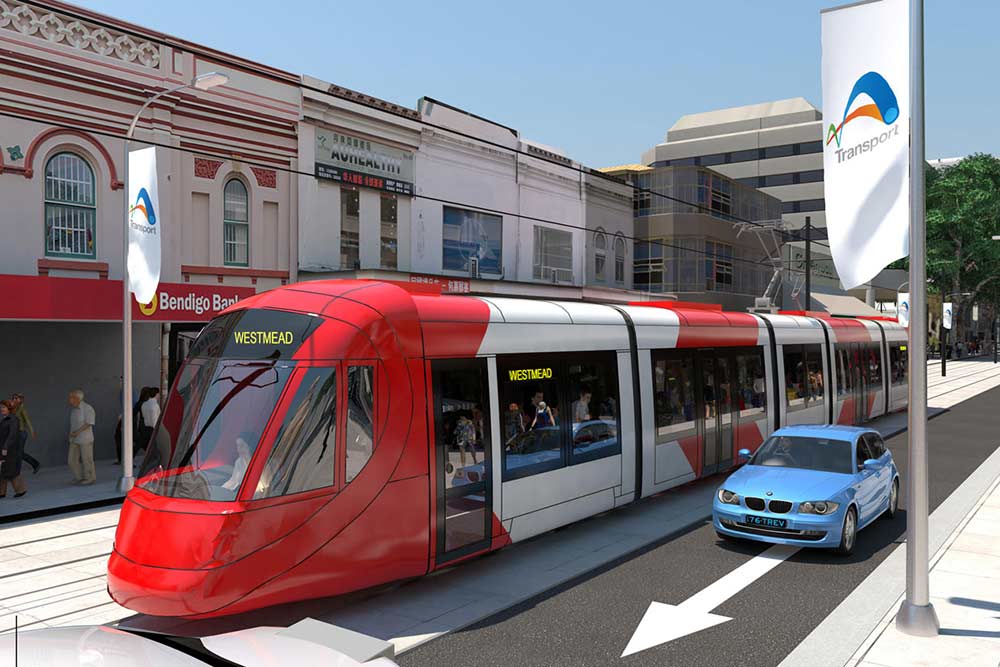
Light Rail Parramatta project – artist’s impression. Image: Transport for NSW
Light rail transportation systems have become a staple of how cities move people around, but now the suburbs are taking the leap to introduce new rolling stock that’s expected to revolutionise how people travel within a metropolitan area.
That’s what the New South Wales government is trying to do in Parramatta, by modelling the success of the Sydney CBD’s light rail infrastructure that’s being expanded as we speak.
The government announced the plans for the Parramatta light rail project in February 2017, in an area which is experiencing significant growth and transformation from being just another outer ‘burb to becoming Sydney’s so-called ‘second CBD’.
And the new light rail is expected to reinforce that label, as Premier Gladys Berejiklian and Minister for Transport and Infrastructure Andrew Constance unveiled the preferred route for the first stage of the Parramatta Light Rail, to join Westmead to Parramatta and Carlingford via Camellia.
The state government has allocated $1 billion to the project from the Restart NSW and Rebuilding NSW funds.
Under the proposed plan, the preferred 12 kilometre line has been released with potential stops at Westmead; Westmead Hospital; Children’s Hospital; Cumberland Hospital; Factory Street; Fennell Street; Prince Alfred Square; Eat Street; Parramatta Square; Harris Street; Tramway Avenue; Camellia; Rydalmere; Dundas; Telopea and Carlingford.
Curiously missing from the Stage One list is Sydney Olympic Park, which as been plagued with transport congestion problems and has proven notoriously difficult to travel to over the years.
The lack of an Olympic Park stop in the first stage of the plan has led to a media backlash to the plan, but in the government’s media release, it states that Sydney Olympic Park will be included in Stage Two of the plan.
“Planning work for stage two of the project, from Camellia to Strathfield via Sydney Olympic Park, is being developed in collaboration with Sydney Metro West. Stage two planning work is expected to be finalised by the end of 2017,” the release said.
Ms Berejiklian said this is a project that will not just connect major parts of Greater Parramatta but also revitalise communities and help create new ones.
“We’ve done the important planning work and are pleased we can unveil the preferred route and proposed stops, which we will now refine in consultation with the community,” the Premier said.
Mr Constance said the proposed 16 accessible stops would operate services from early morning to late at night, every 7 and a half minutes throughout the day.
“Customers won’t have to wait long for a service, they’ll tap on with Opal and board with ease and comfort,” Mr Constance said.
“There’ll also be extra services for special events and we are planning for the system as a whole to be capable of carrying 10,000 people an hour.”
Stage one of the new network connects the major health precinct at Westmead to three campuses of Western Sydney University, Parramatta North, new revitalised places in the Parramatta CBD, upgraded schools, Rosehill Racecourse as well as the new Western Sydney Stadium.
Parramatta MP Geoff Lee said the new light rail line would bring in a new wave of investors to strengthen and revitalise city centres.
“I have worked tirelessly to get the best for the people of Parramatta and I am delighted that the community is now another step closer to having its very own light rail service,” Mr Lee said.
“The government has always said this was an initial down payment for the line, with further funds to be secured from sources including value sharing,” Mr Constance said.
According to the state government, work is continuing to progress the final business case, which will be further advanced once the stop locations are confirmed following this next phase of community consultation.
“Residents, workers, businesses and the broader community are encouraged to continue playing a part in shaping how both the light rail and their neighbourhoods will look, not just today or in five years’ time, but for future generations,” Mr Constance said.
This round of community consultation will contribute towards finalising the Environment Impact Statement (EIS) before it is placed on public exhibition in mid- 2017.





